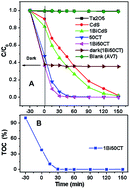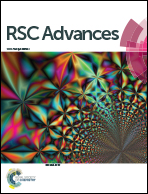Photocatalytic mineralization of anionic dyes using bismuth doped CdS–Ta2O5 composite†
Abstract
A stable and efficient bismuth doped CdS–Ta2O5 heterostructured system is synthesized for the photocatalytic degradation of anionic dyes like acid violet 7, indigo carmine and methyl orange. This composite is found to be effective not only for the degradation but also for the mineralization of these dyes under sunlight type irradiation. Bi doping improves the optical absorption property and enhances the visible light absorption. In this composite, CdS exists as the hexagonal wurtzite structure and Ta2O5 has an orthorhombic structure. Increased fluorescence lifetime is observed for the charge carriers in the composite sample compared to CdS due to the efficient charge separation occurring in this system. The enhanced photocatalytic activity of the composite system arises due to the improved optical absorption properties and increased life time of the photogenerated charge carriers. This heterostructured catalyst is found to be photostable and reusable. Photocatalytic degradation experiments with different quenchers suggest that hydroxyl radicals (OH˙), superoxide anion radicals (O2˙−) and photogenerated holes (h+) play significant roles in the mineralization process.


 Please wait while we load your content...
Please wait while we load your content...